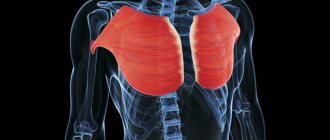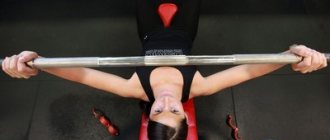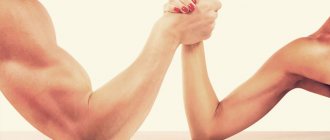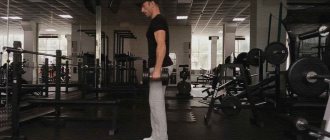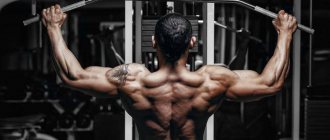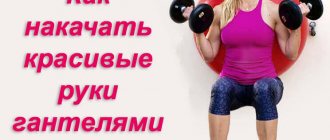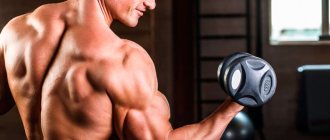It is no secret that the basis of a manly torso is formed by developed pectoral muscles. Therefore, the main goal of training for most men is to work out the pectoral (chest) muscles. Fitness centers offer many options for chest training. But what should those who do not have the opportunity to attend a sports club do? It is for such men that we have selected exercises for the pectoral muscles that can be performed at home.
A little about anatomy
Inflated male breasts evoke the admiration of surrounding ladies and visually increase the relief of the body. Knowledge of the anatomical features of this muscle group is necessary to increase the efficiency and quality of chest training at home.
The pectorals are one of the largest muscle groups in humans. They occupy 3rd place in size and volume. They play a huge role in moving the arms, as well as in raising them up and down.
There are several bundles of pectoral muscles:
- The pectoralis major muscle is fan-shaped and occupies the largest area. Its function includes raising, lowering and turning the arm inward.
- The small muscle is located under the large muscle, has a triangular shape and performs the function of traction forward, down and back. Partially involved in dumbbell or barbell rows (exercises for back development).
- The serratus anterior muscle is located on the side, attached to the shoulder blades. Performs external thrusts and is involved in bringing the arm to a vertical position.
The anatomical structure suggests starting work with the large muscle, since its response to loads is immediate. However, by adjusting the angle at which the exercises are performed, using a set of effective exercises for the chest muscles at home, you can change the degree of load, as well as connect additional muscle groups.
What you need to grow your pectoral muscles
Effective muscle growth depends on several factors:
- A well-designed set of exercises that takes into account the initial physical data.
- Balanced fractional nutrition, which contains all the nutrients the body needs.
- Quality rest, because muscles grow during the recovery period after training.
But the most important factor, without which a qualitative increase in muscle mass is impossible, is the athlete’s brain. Only a competent approach to training and exercise technique will give an acceptable result and protect you from injury.
For example, a chest push-up training program has many advantages. But a technically unprepared athlete will negate all the advantages of the program, since the load, instead of the chest, will be distributed to the triceps and back with the abdominal muscles. The same principle works in nutrition and the use of sports supplements.
Benefits of calisthenics for the pectoral muscles!
So, we have decided that calisthenics is one of the ways to pump up your chest at home and without exercise equipment. What are the advantages of this type of training?
Ability to perform exercises without additional equipment
There is no need to spend money on expensive sports equipment. Of course, there are always options for successful investments. If you want to take push-ups for the pectoral muscles to a whole new level, then it’s worth purchasing special supports. They cost very little, but will allow you to perform all possible push-up variations with maximum efficiency.
You can train anywhere
Being able to train anywhere and anytime is great. You save yourself the hassle of finding a suitable gym and gain the opportunity to be in shape anytime, anywhere.
3. Simultaneous pumping of several muscle groups
For any bodybuilder, the ability to simultaneously use several muscle groups is a big plus. During push-ups, as a rule, the load goes not only on the pectoral muscles, but also, for example, on the triceps. The core muscles also work actively. It turns out that in order to pump up your pectoral muscles, abs and triceps, you just need to do push-ups.
Free workout
Having mastered the technique of performing basic exercises, you can later modify them in order to achieve your goals. By constantly changing the set of exercises, you will achieve better results. It's unlikely to happen quickly, but variety is the key to avoiding getting bored and giving up on exercise.
No excuses for skipping a workout
You can train anytime, anywhere, you don't need any additional equipment, so there's no excuse for missing out. The inability to justify your laziness is a great motivation.
Main rules
Before you start talking about how to properly pump up your pectoral muscles at home, you need to learn some rules that you need to follow during the training process.
Systematic training
There is a system in absolutely all areas of life. This is what happens with sports. You can't exercise once a month and expect any results.
Proper and balanced nutrition
Once a beginner decides to take up exercise, he needs to take one simple step to get started - look in his refrigerator and understand what he eats.
Without the required amount of proteins, fats and carbohydrates, muscle growth is doomed to failure. Without a balanced diet, the pectoral muscles will not grow.
Progression of loads
You can achieve muscle hypertrophy by constantly increasing the load. The fact is that the human body has the ability to adapt. Once this happens, muscle growth stops.
Sport equipment
Unfortunately, without certain sports equipment it will be difficult to achieve impressive results in working out the chest. Of course, you can start training with push-ups, but over time you will have to increase the load, and without additional weights this is impossible.
For example, parallel bars are an effective exercise that can significantly speed up the process of developing the volume of the pectoral muscles.
It is clear that the size of modern apartments does not allow a full-fledged gym with all the necessary equipment to be located at home. But with a few simple devices, you can significantly improve the quality of your training.
For this you will need:
- dumbbells;
- bars;
- horizontal bar;
- a rubber band that can be used as an expander;
- belt - in order to hang additional weight on it;
- bench that can be adjusted in height.
Push-ups on stools
A more effective way to pump up your pectoral muscles with push-ups is as follows. You need to place 2 stools approximately shoulder width apart. Take the starting position, as when doing push-ups from the floor, only place your hands on stools and your feet on the floor or on a raised platform, for example, a sofa or chair. Place your palms slightly wider than your shoulders.
Going as low as possible between the stools, perform 3-4 sets of 10-12 push-ups. Breaks between approaches should be approximately 2-3 minutes.
Setting goals
Bodybuilding is an activity that requires special patience and systematization. If a beginner decides to pump up a massive torso in the shortest possible time, after a month he will be disappointed. After all, it happens quickly and easily only in fairy tales. There are no secret schemes like “the best chest exercises at home - get pumped up in three days.” Since they all work well in their own way, but will not bring visible results in an unrealistically short time.
Also, a lot depends on your body type, genetic predisposition, metabolic rate and the production of your own hormones. Lifestyle also affects the rate of muscle development. But by following simple rules of progression, you can achieve good results.
General recommendations
As you get used to the exercises, it is recommended to create a load while performing push-ups and pull-ups, for example, with a backpack.
First you need to fill your backpack with heavy objects (a heavy book or bottles of warm water).
Don’t chase results in the first week; at the beginning of training, the main thing is not to overdo it with loads during the pumping process.
If the muscles hurt and the unpleasant aching sensation does not go away within a few days after training, you should postpone the next session - it is extremely important that the tissue of the pectoral muscles fully adapt to the new loads.
Every day you should make it a habit to monitor your posture, walk straight, without slouching.
Another important aspect in properly building the relief of a man’s chest is nutrition itself; it is necessary to include in your diet foods rich in proteins (meat, fish, egg whites, nuts, cottage cheese and dairy products).
As practice shows, it is not difficult to make inflated male chest muscles at home.
It is enough to follow the training regimen and the composition and diet.
How to make progress
Here are simple rules that will help you achieve good results in an acceptable time frame:
- Beginners should pay more attention to the technical aspects of exercises and complexes.
- In order for muscles to grow continuously, you need to increase the load in accordance with the established progression threshold.
- Avoid overtraining - muscles need time to recover. You can train your chest no more than 2 times a week.
- Systematization is required not only in training, but also in nutrition and rest. You should spend at least 8 hours a day sleeping. It is highly advisable to adhere to the regime.
- There is no need to neglect your breathing technique. Oxygenated blood allows muscles to grow faster.
In addition to these points, you should follow a training regimen - both during the week and during each lesson.
Training mode
An important aspect in bodybuilding is adherence to the regime. It concerns not only the number of classes per week, but also the training of certain muscle groups during one local workout. Regarding the total number of training days per week, there are many opinions.
Professionals recommend not to get hung up on fixed patterns (Monday - Wednesday - Friday). This way the body will quickly get used to the stress, and a “plateau” effect will occur.
To avoid these moments, you need to alternate training days by month. For example, 12 training sessions according to the classical scheme for a month. Then move on to 16 classes per month. That is, not 3, but 4 workouts (Monday - Tuesday - Thursday - Friday). This will increase the number of training days, and, consequently, the intensity of the load. When finished, return to the original diagram.
If we talk about local training, then you shouldn’t pump your chest at every lesson. Muscles should be allowed to recover.
Accordingly, a beginner’s training looks something like this:
- Monday – chest, triceps, legs;
- Wednesday – back, biceps, crunches;
- Friday – chest, legs, deltoids.
As you can see from the example above, the chest is worked out 2 times a week. This amount of exercise is enough for a man to pump up his sternum muscles.
Is it possible to pump up your chest with push-ups?
You don't have to go to the gym to pump up massive breasts. To do this, you can use an exercise such as push-ups. The beauty of it is that the man’s own weight is used, and if you select the correct push-up pattern for chest muscle growth, progress will not be long in coming.
Push-ups are a great way to remove fat from the chest muscles of a man, as performing this exercise at high intensity leads to an increase in lean muscle mass. Under the load of his own weight, the athlete receives the most optimal weight, due to which fat burns vigorously and quickly.
Push-ups are quite versatile: by adjusting the angle and height of the leg lift, you can work on different parts of the muscle bundles. If you want to pump up the upper and middle of the pectoral muscles, the exercise is also suitable. The higher the legs and the narrower the position of the arms, the greater the load on the upper bundle and the middle section of the pectoral muscle.
Exercises for pumping up the lower part of the pectoral muscles are distinguished by the fact that the angle of inclination shifts and the body rises upward. As a rule, push-ups for this part of the muscle are performed from an elevation or additional support.
For those who seriously want to pump up the middle of the pectoral muscles, like Iron Arnie, push-ups with extremely narrow hand placement will be useful. The main thing in this exercise is not to press your elbows to your torso, since the load from the middle of your chest will shift to the triceps.
Since push-ups are a compound compound exercise, they involve many different muscle groups. But to complete the main task, namely working out the chest, you need to take into account the technical aspects of the training.
The starting position in classic push-ups does not require detailed analysis. The process of doing the exercises is familiar to everyone. But many do not know that the elbows should not be pressed to the body, but placed as wide as possible to the sides. Otherwise, the load will be distributed between the back muscles and triceps. The chest will account for about 15% of the total load.
If we take into account all the technical features of the training, then push-ups can easily be called the best exercises for the pectoral muscles for men at home.
An important fact is that push-ups will not provide the opportunity to build up huge layers of pectoral muscles, since the human body gets used to absolutely any type of load. To progress, you need to constantly increase the load, which is almost impossible to do with push-ups. But they can prepare a beginner for higher levels of weight, and the result will be, although not as pronounced as with training with iron.
How to pump up your pectoral muscles at home
What can you use for training at home? If you have a bench press, barbell and dumbbells at home, you can do a full workout.
Dumbbell training program
The simplest equipment that will help you train beautiful muscles is dumbbells and a bench. This is the minimum without which training for such large muscles will not work. Moreover, the dumbbells must be of sufficient weight to perform the load “to failure” from 8 to 12 repetitions. You can perform the specified complex for training with dumbbells. In one such workout, all parts of the pectoralis major muscle will be loaded. It is important not to forget about rest, to train no more than two days a week.
In addition to developing the bottom and top, it is necessary to pay attention to the middle of the pecs, this will give the correct outline. This can be achieved using exercises with dumbbells, which develop muscles well, as they require additional effort for balance and stability of the technique.
Dumbbell bench press
- We sit on a bench, slightly raising the sternum and tearing off the lower back;
- Dumbbells above the shoulders, without turning the hands, elbows turned to the sides;
- Inhale: lower the dumbbells at shoulder level;
- Exhale: press the dumbbells to the starting position without lowering the chest. Perform the bench press 8 – 12 times for 3 – 4 approaches.
Incline Dumbbell Flyes
This exercise involves an isolating load, during which the muscle is stretched. When working on an angled bench, the upper pectoral muscles are involved.
- Set the bench at an angle of 45 degrees;
- Lying on a bench, we round the chest, maintaining the position throughout the entire exercise. Place the dumbbells above your shoulders, bending your elbows slightly and turning them slightly to the sides;
- Inhale: spread the dumbbells to the sides, holding the angle at the elbows, feeling the stretch;
- Exhale: bring the dumbbells to the middle of the body to the starting position. Perform wiring 8 – 12 times in 3 – 4 approaches.
Pullover with dumbbells
The dumbbell row from behind the head while lying down is performed not only with the help of the pectoralis major, but also the latissimus dorsi, teres major, pectoralis minor, serratus anterior muscles, and the long head of the triceps brachii.
- Lying down, place your feet with emphasis on the bench, two hands clasp the top of the dumbbell;
- Rounding the chest, lifting the lower back from the bench, we maintain the position;
- Place the dumbbell on outstretched arms, elbows slightly bent;
- Inhale: lower your hands behind your head, stretching your chest;
- Exhale: using the efforts of the pectoral muscles, we return the dumbbell to its original position. We perform 3–4 approaches 8–12 times.
How to pump up your chest without iron using push-ups
As already mentioned, for high-quality and effective training it is necessary: the number of repetitions is no more than 12, work “to failure” with maximum weight. Naturally, by doing 12 push-ups, you will not get the optimal load for muscle growth.
With each workout, the muscles become stronger, so they can perform more and more repetitions to feel tired. And this is already work on the development of endurance, in which the muscles do not increase in volume; in this mode, fat is rapidly burned. And if you eat improperly, your muscles can also burn. Therefore, push-up exercises will help strengthen the pectoral muscles, but they will not be enough for growth.
Push-up program for chest muscles
- Dips. As you get used to the load, you can add weight using a special belt and free equipment (dumbbells, weights). Perform no more than 12 repetitions of 4 sets.
- Triceps push-ups with your back to the bench. Additional muscles in the exercise are the pectoralis major. For greater difficulty, you can put weights on the bird and perform the exercise 12 times. Palms under shoulders on a bench, feet on a bench located parallel. As you inhale, bend your elbows, lowering your body below the bench. As we exhale, we do push-ups.
- Pushups.
- to develop the upper chest, place the feet on a hill;
- to develop the lower part, place the palms on a hill;
- to develop the outer part of the pectorals, place your palms wide;
- to develop the internal part, place your palms narrowly.
To improve your push-up results, you can use additional weight, such as placing a weight plate on your back or using a resistance band, like in the video above.
The best chest exercises for home
When it comes to training at home, the thought immediately comes to mind that there are not so many exercises for a certain muscle group. Don’t despair, if you have a few simple devices you can significantly diversify your home workout, and even a beginner will have no problems pumping up his chest at home.
Pushups
Push-ups are one of the most popular exercises for pumping up the pectoral muscle.
Starting position – lying down, the body from head to heels should form a straight line. As you inhale, you need to lower your body to the floor, bending your arms at the elbow joints, and as you exhale, return to the starting position. There is no need to press your elbows to your body.
Dips
Pumping up your chest at home on the uneven bars is quite possible.
The athlete's body should be suspended, with the arms acting as a support. For maximum load on the pectoral muscles, you need to move your body forward.
On inhalation - descent, on exhalation - return to the starting position. Elbows bend to the sides. It is important to prevent swinging, as in a pendulum mechanism.
Pull-up on the horizontal bar
Exercises on the horizontal bar are also good for pumping up your torso and pectoral muscles. The horizontal bar engages the lower part of the chest, giving it relief.
The technique is quite simple. The athlete is hanging, the grip of the hands is slightly wider than shoulder width. As you exhale, you need to pull your body towards the bar so that your chest touches it. While inhaling, return to the starting position.
Dumbbell Bench Press
How to pump up your chest with dumbbells at home? Very simple - you will need a bench for this. Starting position – lying on a bench. The arms, bent at the elbow joints, form a right angle and are placed to the side. As you exhale, you need to squeeze the dumbbells up, and as you inhale, return to the starting position.
It is better to take dumbbells to the starting position from a sitting position. The dumbbells are placed with their ends on the top of the thigh, then, without leaving the sitting position, you should lean back with your whole body. The lying position should resemble the position in which the person is sitting. This is done in order to remove the arch in the back and give maximum load to the chest.
Dumbbell flyes in a lying position
When reaching the starting position, it resembles a dumbbell bench press. Except that you don’t need to press them, but spread your arms to the sides. Slightly bent elbow joints are lowered to the line of the body, then the arms are brought together.
Women who are looking for an answer to the question of how to quickly pump up their pectoral muscles at home should know that exercises with dumbbells will help tone their breasts. Of course, the weight of the shells will differ significantly from the loads for men.
Chest exercises with iron
Although it is quite possible to build great pectoral muscles without weights, adding a little weight can help develop your chest. These exercises can be done either at home or at the gym, and all you need is a pair of dumbbells. Adding weights will also open you up to many other effective chest exercises, such as the bench press.
If you are a beginner, it is advisable to start with light weights to learn the correct technique first. Once you gain confidence, begin to gradually increase the weight until you find it difficult to complete the last 3-4 reps.
Just like with push-ups, body position is important. It depends on which muscles will be used.
Regular Bench Press
Lie down on a bench press, holding dumbbells in your hands. Extend your arms above your body, keeping them shoulder-width apart. This will be the starting position. Now take a deep breath and slowly lower the dumbbells until your elbows are bent at right angles, parallel to the floor. After this, lift the dumbbells to the starting position.
Bench press with positive incline
Lie on an incline bench holding dumbbells in your hands. Stretch your arms up, keeping them shoulder-width apart. Hold your wrists so that your palms face each other. Slowly lower your arms down while taking a deep breath. Then, as you exhale, lift them up, engaging your chest.
Negative Incline Bench Press
Secure your feet at the end of a downward-sloping bench. Lie on it, hold dumbbells in your hands. When you are comfortable, raise your arms above you, keeping them shoulder-width apart. The palms should be facing each other. Slowly lower your arms until your elbows are parallel to the floor. After this, slowly press back to the starting position, exhaling and tightening your chest muscles.
Dumbbell curls
Lie on a flat horizontal bench, holding dumbbells in both hands, palms facing each other. Straighten your arms above your body, shoulder-width apart. Bend your arms slightly at the elbows. Do not fix your elbows - they should remain mobile. Stretch your arms out to the sides until you feel your chest muscles stretch. After this, return your hands to the starting position. Remember that it is not the elbow joints that should work, but the shoulder joints.
Raising your arms upward
Lie on a bench inclined upward, holding dumbbells in both hands, palms facing each other, as in the previous exercise. Extend your arms above your body, shoulder-width apart. Also, do not fix the position of your elbows - they should remain mobile. Extend your arms at right angles to your body until you feel your pectoral muscles stretch. Bring your arms back to the starting position, tensing your chest muscles. The upper chest is worked.
Bringing your hands together on a bench with your head down
Secure your feet to the end of an incline bench and lie down on it, holding dumbbells in your hands. You need to technically perform the exercise described above. This involves the lower part of the pectoralis major muscle.
Dips
Vertical push-ups are an excellent exercise for the chest muscles. Some even claim that it is the best of all. Such push-ups not only add relief, but also volume. Additionally, your body is not supported by a bench like a bench press, so many other muscle groups in the body are involved because they will have to stabilize it.
No weights are needed for this exercise. Instead, you'll need a setup like this: two parallel bars or surfaces between which you'll perform vertical push-ups (two stable bar stools work great, too). Grab the bars or chairs with your hands and bend your knees slightly. Slowly lower your body, bending your elbows. Elbows should be pointing outward. When you feel a stretch in your chest, stop. If you continue to lower yourself, you can damage your shoulder joint. As you exhale, tighten your chest muscles, returning your body to its original position.
Chest training program for home
Such training requires a lot of strength and discipline. For example, there is a task - to pump up the inner part of the pectoral muscles at home - not all exercises are suitable for this. First of all, you will need push-ups from the floor with a narrow position of your hands.
It is very important to understand which tasks to apply this or that exercise to.
Reheating options
An important part of any workout is warming up. Prepared muscles respond better to stress and reduce the risk of injury.
- Squat jumps. You need to squat down and jump up from this position. As soon as the return to the starting position occurs, change the position to a lying position and perform a push-up. The repetition ends with a return to a squat.
- Plank. An indispensable exercise for toning muscles, and also as a warm-up before training. To perform it, take a lying position and stand there for 30 seconds to 2-3 minutes.
Set of exercises
To fully work out the chest muscles, you will need several workouts per week.
The first workout looks something like this:
- Push-ups – 3 sets of 10 repetitions.
- Wide grip pull-ups – 10 reps in 3 sets.
- Push-ups on parallel bars – 3-4 sets to failure.
For the maximum pumping effect, you can perform a superset of effective exercises on the top of the pectoral muscles and, accordingly, on the bottom.
Complex No. 2 includes working with weights, and it is this that will help pump up the lower pectoral muscles with dumbbells:
- Dumbbell bench press – 3 x 10.
- Dips with additional weight – 3-4 x 10 reps.
- Pullover with a barbell or dumbbells – 3 sets of 10 reps.
- Lying arm raises with dumbbells – 10 times in 3 sets.
What equipment do you need to have for training?
But sports equipment will never be superfluous in this difficult task. Therefore, if you have such an opportunity, then why not take advantage of it?
To make your breasts larger than your girlfriend’s, you may need dumbbells, discs, a weighted vest or a backpack where you will put all sorts of heavy things to make it harder for you to do push-ups, and people will come up who will be ready to sit on you.
We recommend reading: Program for gaining muscle mass in the gym for men
Now I’ll explain what you need:
- Using dumbbells, you can do fly-ups while lying on the floor. You can also do a dumbbell bench press if you are an engineer with your mother and can make yourself a surface on which it will be comfortable for you to lie and lower your elbows so that nothing bothers you.
- You will need discs for push-ups if you are already a machine and it’s already easy for you to do push-ups with your own weight. If there are no discs, but there are small people (children), then you can ask them to sit on your back.
- The vest is suitable for push-ups on parallel bars or the same push-ups from the floor. This is perhaps the most convenient option to complicate your task.
- If you have a backpack and you have something heavy that fits in it, then you can throw it on your back and go do push-ups.
So I will never believe that someone doesn't have the opportunity to train at home because they don't have anything to train with. You have arms, legs and a bunch of objects that can be used in training. Even if there’s sawdust in your head, it’s not a problem, it doesn’t take much intelligence to throw a few books into your backpack, lie down on the floor and start doing push-ups.
Now let's take a closer look at how to pump up your chest at home by looking at specific training programs.
Uplifting the upper chest
Of course, pumping up the upper pectoral muscles using a machine in the gym is easier and more convenient. But there are also other exercises to develop this area, and they can be used at home. Using different weights and the angle of the bench or leg elevation in push-ups, you can increase the effectiveness of training at home.
Exercises for pumping the upper pectoral muscles at home are simple and effective. For example, in a dumbbell bench press, it is enough to change the position of the body by raising the bench 30-46 degrees upward.
To pump up the upper muscles of the sternum for a man, you can perform various exercises, focusing purely on your sensations. It is important to try to get a feel for the group being worked on and a certain part of it. Only in this case will any exercise give quick results.
Pushups
One of the basic exercises for pumping up the pectoral muscles is the simplest push-up.
Strength training for push-ups is general developmental; these are basic strength exercises.
Push-ups will help:
- pump up your chest;
- involve the development of biceps.
In addition to this, the abdominal muscles are trained, the muscles of the back and legs are involved.
This is the simplest and most effective exercise of all those invented in response to the question of how to pump up a man’s chest purely at home.
During push-ups, it is necessary to use the possibilities of shifting the load to the top or bottom of the chest, changing the angle of the torso.
Working on the lower pectoral muscles
The training program on the horizontal bar to properly pump up the chest muscles of a man is quite simple, but at the same time effective. It is enough to do pull-ups 2-3 times a week in different positions.
There are “Australian pull-ups” that perfectly develop not only the back, but also the lower chest. To perform this exercise, you need a horizontal bar no more than 1 meter high. Pull-ups are performed reclining. The body forms one straight line with the legs; grips can be different.
The “pullover” exercise will help pump up the lower pectoral muscles with dumbbells. It is mainly done on a lying bench, with dumbbells or a barbell. Starting position – hands with dumbbells in front of your head in a vertical position. As you inhale, you need to bring your arms to a horizontal position behind your head, without bending them at the elbows. Then bring them to their starting position.
Many people ask the question of how to pump up the lower chest in a week with a barbell. In practice, it is impossible to achieve any results in a week. Bodybuilding is an activity for patient and persistent people. He is in no hurry.
Nutrition and basic recommendations for beginners
Proper nutrition is the key to progress. If the exercises are performed regularly, with proper technique, but the diet is composed incorrectly, there can be no talk of progress. In some cases, even regression is possible. It all depends on the characteristics of the human body. The main rule for gaining weight and increasing muscle size is that the amount of calories consumed must exceed the amount consumed. In addition to quantity, the quality of food is also important. In this case, foods containing simple carbohydrates and sugars are not suitable. They provide a short-term burst of energy, which is quickly consumed.
Protein and complex carbohydrates are important for gaining muscle mass. The former are found in meat, eggs, fish and dairy products, and the latter in cereals, pasta and baked goods. At first, 1-2 g of protein per 1 kg of a man’s body weight is enough. Subsequently, it is advisable to increase to 2.5-3 g of protein per 1 kg of human weight. They are the building blocks of muscles, and carbohydrates provide energy for exercise. It is also necessary to drink enough water. Its consumption should be 1.5-2.5 liters per day, depending on body weight.
Healthy eating
To pump up your chest, you need to alternate training and rest. Muscles do not grow during physical activity, but after it, during the recovery period. The optimal schedule is 2-3 times a week. You can exercise 4 times a week, provided that the exercises of each next day are aimed at different muscle groups. Any workout should not exceed 1.5 hours. This is the maximum time for effective training. Otherwise, you should reconsider your approach to the training process.
Usually the chest is pumped along with the muscles of the back and shoulder girdle. The latter include the deltoids, triceps and neck muscles. The trapezius and latissimus muscles are developed on the back. It is they together that give the notorious inverted triangle that every man strives for.
There are different methods for performing the exercises, but for a beginner it will be enough to do 4 sets of 8-12 repetitions of each exercise. If you feel the strength to do more, it means that the weight chosen is too light and the exercise is easy. If it is difficult to do even 8 repetitions, it means that the weight is selected more than necessary.
As a rule, each person has one pectoral muscle larger than the other. Sometimes the imbalance is too obvious. You should not load the lagging breast more than the other. In most cases, self-correction occurs during exercise and the muscles become almost symmetrical. In rare cases, you can do 1 additional approach to load less developed muscles.
Do not pump one pectoral muscle more than the other
Exercises should be performed with warm muscles, so each workout should begin with a warm-up. This is necessary in order to avoid sprains and other injuries. You need to warm up not only the muscles being loaded, but also the rest, starting from the head and ending with the legs. After all, exercises involve not only the main muscles, but also many auxiliary ones.
Advice from professionals
Do not grab large weights of dumbbells or barbells at the very beginning. Also, you don't need to tear your muscles with a huge number of repetitions. During the first month of training, a beginner only begins to learn the basics of working out various muscle groups. The neuromuscular connection is not yet properly adjusted, which means there is a high risk of injury.
Instead, it is better to try to pay maximum attention to the technical aspects of the exercises, since technique plays a vital role in bodybuilding. And then the result will not be long in coming.
Another point is nutrition. Only a balanced diet will allow you to saturate your body with the necessary nutrients that promote muscle growth.

